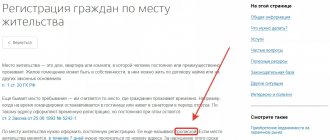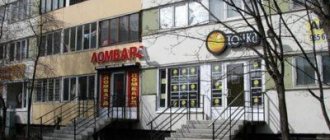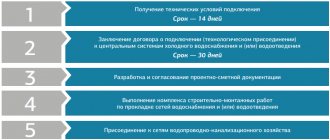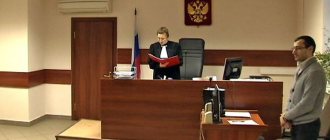New rules for paying for general house needs using the ODPU meter
Starting from 2022, according to the new rules, it is customary to calculate payment for common house needs using a common house metering device - ODPU . According to the legislator, the innovation will allow payments to be made for actual resources spent in regions such as the Moscow region and others.
For apartment buildings, the downside is the difficulty of calculating general house consumption using individual meters, for example, calculating cold water. Not all residents are willing to spend a fortune to install them. A good option would be to add personal ODPU counters. In this case, the presence of losses is monitored and the home serviceability of communication networks is checked.
Houses exempt from the need to establish ODPU:
- buildings that are in disrepair or recognized as dilapidated;
- electricity consumption is less than 5 kW/h;
- natural gas consumption no more than 2 cubic meters. m/h;
- thermal energy consumption no more than 2 Gcal/h.
If a tenant does not have the technical capabilities to establish personal and DPPU (the criteria are specified in the order of the Ministry of Economic Development dated November 29, 2011 No. 967), then he must pay extra for utilities.
When manifold wiring the heating system, mechanical and ultrasonic IPUs are used
Heat meters for manifold heating distribution in an apartment building are a calculator installed on a flow meter with two temperature sensors. One sensor is screwed into the flow meter itself, the second into a tap installed on the heating return pipe. Thus, the heat meter takes into account the volume of coolant and the temperature difference. As a rule, calculations are made in Gcal.
Thermal energy meters for manifold distribution of heating systems
Based on the principle of resource accounting, heat energy meters for collector wiring of the heating system in apartment buildings are divided into:
- mechanical,
- ultrasonic.
In mechanical meters, as in water meters, an impeller is installed; rotating, it transmits information about the volume of coolant to the corresponding display. In ultrasonic meters, this function is performed by a special ultrasonic element, therefore such metering devices are considered more reliable: there is nothing to break in them.
Example of an ultrasonic heat energy meter
Heat metering devices for collector wiring may differ in their data transmission interface, which is important if the house uses a remote dispatch system. The interface can be made in three versions: pulse output, M-Bus and RS-485. By default, meters are equipped with a pulse output or are produced without any data transfer interface at all.
How the scheme for replacing and operating electricity meters has changed
Sequence of actions during installation of ODPU
Installation of heating equipment is carried out by enterprises with special permits.
Steps for installing meters:
- positive installation decision by all homeowners;
- selection of an organization specialized in installation;
- fixing the installation location and additional control;
- obtaining technical certificates for installing the device;
- approval of design and estimate documentation;
- preparation of papers and their coordination with the supplier;
- purchase of equipment;
- installation of a metering device;
- additional work on launching and configuring equipment.
In accordance with clause 13 of Article 13 of the Federal Law “On Energy Saving”, all costs for installing ODPU are paid by the owners of the resource supplying organization.
Requirements for water supply systems
Under operating conditions, meters often fail; in order to minimize the number of replacements, it is necessary to monitor their serviceability.
Requirements for pipes:
- high-quality and clean water;
- stable pressure;
- without external or internal damage;
- no air bubbles.
To increase reliability parameters, it is necessary to use backup equipment.
Who is financially responsible?
The installation of communal metering devices is fully paid for by homeowners.
As part of the assistance, the state allows the use of installments for 5 years , during which time the amount spent on the installation of equipment is indicated in utility bills. If it is possible to pay in one payment, then the payment is made before or after installation.
Example: If the area of the premises is 120 sq.m., the area of the house is 10,000 sq.m., the total property (basement, playground) is 2,000 sq.m., the owner pays: 120 / 10,000* 2,000 = 24 sq.m. m.
Criteria for influencing the cost of common house metering devices
To calculate the installation of ODPU, it is necessary to measure the area of the apartment of each resident and multiply by the cost of the meter per 1 sq.m.
Calculation example: 56.8 sq. m. * 91.7 rub. = 5,208.6 rub.
In the case of a general decision to install, using installments, it is necessary to divide the calculated cost by 60 (the number of monthly payments for five years).
Calculation example: RUB 5,208.6 : 60 = 86.8 rub. monthly fee.
Additionally, the Housing Code prescribes specific criteria on which the establishment of the DPPU will depend.
These include: payment for the cost of the device, preliminary consultation, drafting a project, payment for installation, setting up and launching the device, five-year maintenance.
Housing and communal services news
News
Dear residents, dear participants of the “New Year's account will bring gifts” campaign!
We have winners!
Congratulations to our lucky winners! We invite you to check whether luck has smiled on you by looking at the minutes of the meeting of the counting commission to determine the winners of the promotion!
You can see how the winners were determined in this video.
The New Year's account will bring gifts. Determination of the winners
Minutes of the meeting of the counting commission to determine the winners of the promotion
The New Year's account will bring gifts. Participants of the action
Dear friends! There are 28,657 participants in our promotion! Have you become one of them?
Find out now! Download the file with the name of your house management company and find your personal account number in it.
Found it? Congratulations! You are one of the contenders for prizes!
You can find your personal account number in the bills from your house management company (personal account number starts with 989...).
You can quickly find your personal account number in the downloaded file by searching the document. Press the key combination Ctrl+f and enter nine digits of your personal account, press ENTER.
Write down your serial number located opposite your personal account number, because it is this number that will be used to determine the winners on December 23!
Follow the news!
Moscow DUK Participants of the action.pdf
Janitors of the building management company of the Moscow region are intensively clearing the surrounding areas of apartment buildings from snow and ice, sprinkling sidewalks with de-icing materials
Delivery of advance payment documents to recipients is ending!
This means that very soon residents of apartment buildings in the Kanavinsky, Moskovsky, Nizhny Novgorod, Sovetsky and Prioksky districts of Nizhny Novgorod will be able to pay the “New Year’s” advance payment for December and take part in the “New Year’s account will bring gifts” campaign
Employees of the management company of the Moscow region helped the Center for Support of People with Disabilities
https://vk.com/wall-174467745_400?w=wall-174467745_400
House management companies of the Kanavinsky, Moskovsky, Nizhny Novgorod, Prioksky and Sovetsky districts of Nizhny Novgorod announce the start of the “New Year's account will bring gifts!” campaign.
Pay an advance receipt for housing and communal services and get the opportunity to become the owner of one of 70 valuable prizes!
The winners will receive 40 certificates
for payment of housing and communal services with a nominal value of
3,000 rubles
,
25 certificates
for payment of housing and communal services with a nominal value of
5,000 rubles
and
5 super-certificates
for payment of housing and communal services with a nominal value of
10,000 rubles!
Promotion period
– from December 01, 2021 to December 30, 2021 inclusive.
Residents who are consumers of the company’s services and who have fulfilled the terms of the Promotion take part in the promotion.
To participate in the promotion you must:
- pay the current receipt for November until December 10, 2021 inclusive;
- pay the advance receipt for December until December 15, 2021 inclusive;
- follow the progress of the action on the websites of the management company and in the VKontakte group.
Additional information about the promotion can be obtained from the housing and communal services contact center by calling 268-10-00
(24/7), as well as
in the official group of house management companies on VKontakte
– https://vk.com/dukinizhnego.
Information about the organizer of the event, the rules of its holding, the number of prizes or winnings based on the results of the event, the timing, place and procedure for receiving them can be found by clicking on the link:
REGULATIONS FOR THE PROMOTION “THE NEW YEAR’S ACCOUNT WILL BRING GIFTS!”
The nuances of paying for common house metering devices
The payment amount is not distributed equally among all residents. Each payment for indicators occurs according to personal meters, depending on the size of the living space with allowances for maintenance. Commercial organizations also pay their ODPU in the receipt for the apartment separately from everyone else.
If the amount in the receipt appears to be overestimated, then you can submit a written application for a detailed explanation of the calculation formulas and the readings of general and personal meters. If the management company refuses to provide information, you must contact the prosecutor's office.
Calculation of non-residential premises
When calculating resource consumption, it is necessary to include in the cost of the area what belongs to all residents, regardless of personal metering devices.
Tariff calculation formula:
Rho = (P – P ind)*T , where:
- Ro - amount of payment for joint maintenance of places;
- R - total flow rate;
- Rind - the amount of energy resource consumption taken from individual metering devices;
- T – tariff size of a specific resource.
In order to encourage residents to purchase communal metering devices, the state uses tariff surcharges for persons who refuse to establish a general household metering device.
Please note: in addition to individual consumption of water, gas and electricity, the receipts include payment for general household expenses. This system is necessary to detect leaks in pipes from the organization supplying resources to the home.
Payment of receipts using the example of heating
To carry out calculations, special formulas have been developed in accordance with the availability of metering devices.
| Availability of equipment | Calculation example | Formula |
| Only a common house meter | Every month, the meter readings are divided by the total area of the entire building. Having received what was spent on 1 sq.m. the number of calories is multiplied by the heating tariff with the sum of the areas of the apartment with the adjacent share | Pi = Vd * x Si / Sob * T, Where:
|
| General and individual metering devices | Used when it is possible to spread pipes horizontally (high-rise buildings). From the ODPU readings for heating, the total reading from all apartment meters is subtracted. Then the resulting value is increased by the share of each apartment and by the established tariff with heating charges. | Pi = (Vin + Vi one * Si / Sob )*T), Where:
|
| Lack of a personal meter in a separate apartment | ODPU readings are taken from all metering devices available in a particular apartment, minus the difference with the ratio of the common building meter, the resulting result is divided by the area of the entire house and multiplied by the sum of the area and the share of apartments without a meter. Only after this is multiplied by the heating cost per 1 cubic meter. m. | Pi = (Vi + Si * (Vd - ∑Vi) / Sob)xT, Where:
|
The amount of monthly deduction for the provision of services is the result of the formulas.
Thus, despite a number of disadvantages of ODPU and the forced nature of installation, it allows you to reduce the amount of resources consumed, thereby reducing the monthly expenses of an apartment building.










